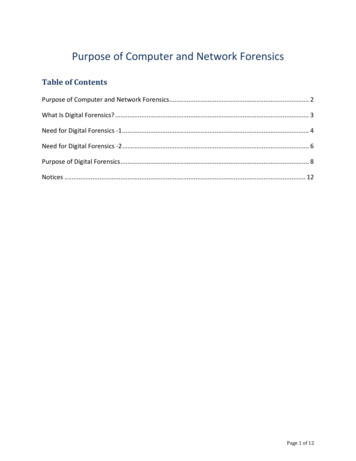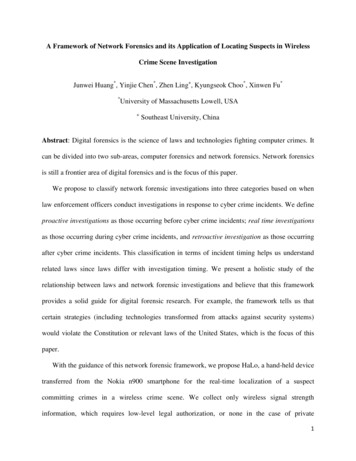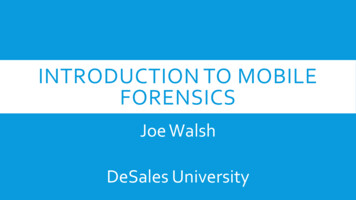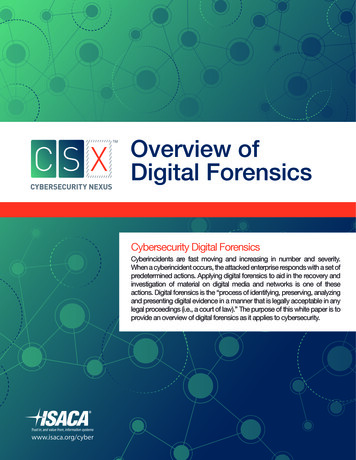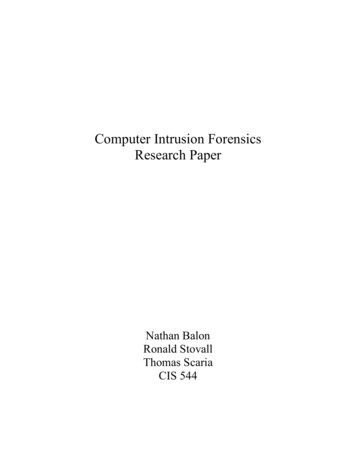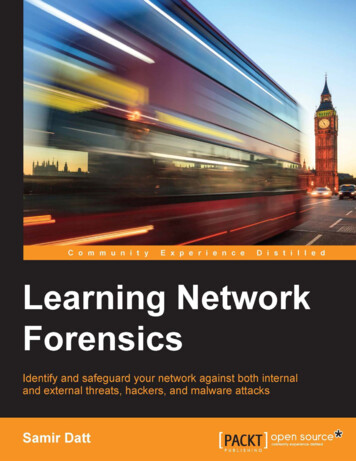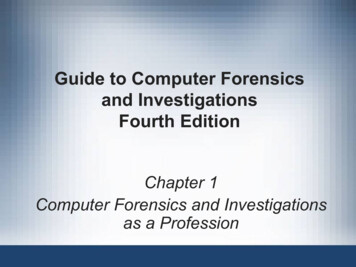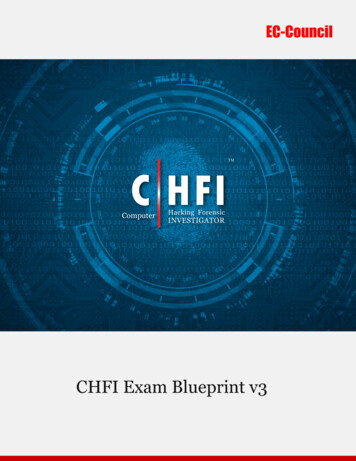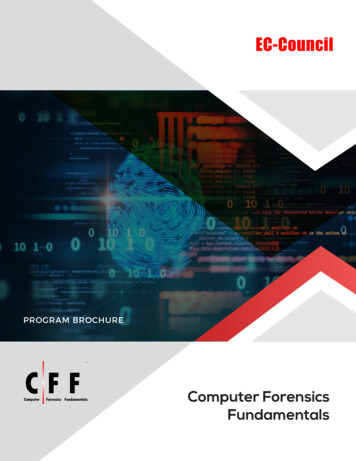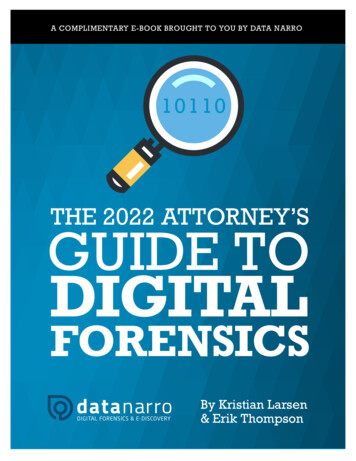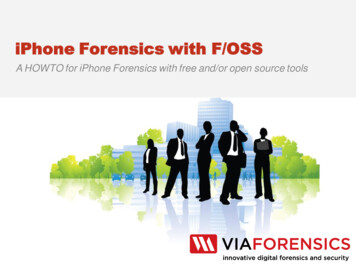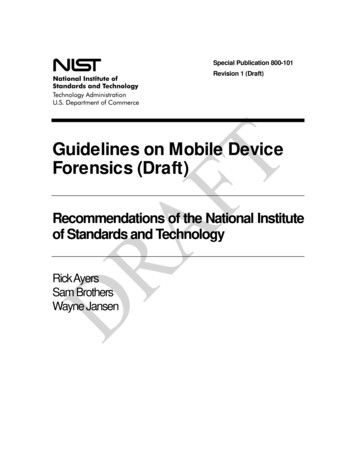
Transcription
Special Publication 800-101Revision 1 (Draft)Guidelines on Mobile DeviceForensics (Draft)Recommendations of the National Instituteof Standards and TechnologyRick AyersSam BrothersWayne Jansen
NIST Special Publication 800-101Revision 1Guidelines on Mobile Device Forensics(Draft)Recommendations of the NationalInstitute of Standards and TechnologyRick AyersSam BrothersWayne JansenSOFTWARE AND SYSTEMSSoftware and Systems DivisionInformation Technology LaboratoryNational Institute of Standards and TechnologyGaithersburg, MD 20899-8930September 2013U.S. Department of CommercePenny Pritzker, SecretaryNational Institute of Standards and TechnologyDr. Patrick D. Gallagher, Under Secretary forStandards and Technology and Director
Reports on Computer Systems TechnologyThe Information Technology Laboratory (ITL) at the National Institute of Standards andTechnology (NIST) promotes the U.S. economy and public welfare by providing technicalleadership for the Nation’s measurement and standards infrastructure. ITL develops tests,test methods, reference data, proof of concept implementations, and technical analysis toadvance the development and productive use of information technology.ITL’sresponsibilities include the development of technical, physical, administrative, andmanagement standards and guidelines for the cost-effective security and privacy of sensitiveunclassified information in Federal computer systems. This Special Publication 800-seriesreports on ITL’s research, guidance, and outreach efforts in computer security and itscollaborative activities with industry, government, and academic organizations.National Institute of Standards and Technology Special Publication 800-101 (Revision 1)Natl. Inst. Stand. Technol. Spec. Publ. 800-101 (Revision 1), 85 pages (2013)Certain commercial entities, equipment, or materials may be identified in this document inorder to describe an experimental procedure or concept adequately. Such identification isnot intended to imply recommendation or endorsement by the National Institute ofStandards and Technology, nor is it intended to imply that the entities, materials, orequipment are necessarily the best available for the purpose.
AcknowledgementsThe authors, Rick Ayers from NIST, Sam Brothers from U.S. Customs and Border Protection andWayne Jansen from Booze-Allen-Hamilton, wish to thank colleagues who reviewed drafts of thisdocument. In particular, our appreciation goes to Barbara Guttman from NIST and Simson Garfinklefrom the Naval Postgraduate School for their technical support and written contributions to thisdocument.Our appreciation also goes out to Bob Elder from TeelTech Canada, Gary Kessler from Gary KesslerAssociates, Daren Melson and Rick Mislan from Rochester Institute of Technology and for theirassistance on technical issues that arose in our work. The authors would also like to thank all otherswho assisted with our review process.
DRAFT SP 800-101 Rev. 1, Guidelines on Mobile Device ForensicsTable of ContentsTABLE OF CONTENTS . VLIST OF FIGURES .VIILIST OF TABLES . VIIIEXECUTIVE SUMMARY. 11. INTRODUCTION. 21.11.21.31.4AUTHORITY . 2PURPOSE AND SCOPE . 2AUDIENCE AND ASSUMPTIONS . 3DOCUMENT STRUCTURE . 32. BACKGROUND. 42.12.22.32.4MOBILE DEVICE CHARACTERISTICS . 4MEMORY CONSIDERATIONS . 6IDENTITY MODULE CHARACTERISTICS . 8CELLULAR NETWORK CHARACTERISTICS. 113. FORENSIC TOOLS. 163.13.23.33.4MOBILE DEVICE TOOL CLASSIFICATION SYSTEM . 16UICC TOOLS . 23OBSTRUCTED DEVICES . 24FORENSIC TOOL CAPABILITIES . 264. PRESERVATION . 284.14.24.34.44.54.6SECURING AND EVALUATING THE SCENE . 28DOCUMENTING THE SCENE. 29ISOLATION . 29PACKAGING, TRANSPORTING, AND STORING EVIDENCE . 34ON-SITE TRIAGE PROCESSING . 34GENERIC ON-SITE TRIAGE DECISION TREE . 365. ACQUISITION . 385.15.25.35.45.5MOBILE DEVICE IDENTIFICATION . 38TOOL SELECTION AND EXPECTATIONS . 40MOBILE DEVICE MEMORY ACQUISITION . 41TANGENTIAL EQUIPMENT . 46CLOUD BASED SERVICES FOR MOBILE DEVICES . 486. EXAMINATION AND ANALYSIS. 506.1 POTENTIAL EVIDENCE . 506.2 APPLYING MOBILE DEVICE FORENSIC TOOLS . 526.3 CALL AND SUBSCRIBER RECORDS. 54v
DRAFT SP 800-101 Rev. 1, Guidelines on Mobile Device Forensics7. REPORTING . 588. REFERENCES . 61APPENDIX A. ACRONYMS . 66APPENDIX B. GLOSSARY . 69APPENDIX C. STANDARDIZED CALL RECORDS . 74APPENDIX D. ONLINE RESOURCES FOR MOBILE DEVICE FORENSICS . 77vi
DRAFT SP 800-101 Rev. 1, Guidelines on Mobile Device ForensicsList of FiguresFigure 1: Memory Configurations . 7Figure 2: SIM Card Size Formats [Orm09] . 9Figure 3: SIM File System (GSM) . 10Figure 4: Cellular Network Organization . 13Figure 5: Satellite Phone Network . 15Figure 6: Mobile Device Tool Classification System . 18Figure 7: Generic Triage Decision Tree . 37vii
DRAFT SP 800-101 Rev. 1, Guidelines on Mobile Device ForensicsList of TablesTable 1: Hardware Characterization . 5Table 2: Software Characterization . 6Table 3: Mobile Device Forensic Tools . 21Table 4: Memory Cards. 48Table 5: Example Record Structure. 74Table 6: Technical Resource Sites . 77Table 7: Databases for Identification Queries . 77viii
DRAFT SP 800-101 Rev. 1, Guidelines on Mobile Device ForensicsExecutive SummaryThe digital forensic community faces a constant challenge to stay abreast of the latesttechnologies that may be used to expose relevant clues in an investigation. Mobile devices arecommonplace in today’s society, used by many individuals for both personal and professionalpurposes. Mobile devices vary in design and are continually undergoing change as existingtechnologies improve and new technologies are introduced. When a mobile device isencountered during an investigation, many questions arise: What is the best method topreserve the evidence? How should the device be handled? How should valuable orpotentially relevant data contained on the device be extracted? The key to answering thesequestions begins with a firm understanding of the hardware and software characteristics ofmobile devices.Mobile device forensics is the science of recovering digital evidence from a mobile deviceunder forensically sound conditions using accepted methods. Mobile device forensics is anevolving specialty in the field of digital forensics. This guide attempts to bridge the gap byproviding an in-depth look into mobile devices and explaining the technologies involved andtheir relationship to forensic procedures.The goal of mobile forensics is the practice of utilizing sound methodologies for theacquisition of data contained within the internal memory of a mobile device and associatedmedia providing the ability to accurately report one’s findings.This guide also discusses procedures for the preservation, acquisition, examination, analysis,and reporting of digital evidence. The issue of ever increasing backlogs for most digitalforensics labs is addressed and guidance is provided on handling on-site triage casework.The objective of the guide is twofold: to help organizations evolve appropriate policies andprocedures for dealing with mobile devices and to prepare forensic specialists to conductforensically sound examinations involving mobile devices. This guide is not all-inclusive noris it prescribing how law enforcement and incident response communities should handlemobile devices during their investigations or incidents. Specific vendors and mobile forensicacquisition guidance is not specified. However, from the principles outlined and otherinformation provided, organizations should find this guide helpful in setting their policies andprocedures. This publication should not be construed as legal advice. Organizations should usethis guide as a starting point for developing a forensic capability in conjunction with propertechnical training and extensive guidance provided by legal advisors, officials, andmanagement. This guide is the first revision to NIST SP800-101. While some of theinformation provided herein has been duplicated from the original guide, much has beenupdated to reflect the current state of the discipline.ES-1
DRAFT SP 800-101 Rev. 1, Guidelines on Mobile Device Forensics1. Introduction1.1AuthorityThis publication has been developed by NIST to further its statutory responsibilities under theFederal Information Security Management Act (FISMA), Public Law (P.L.) 107-347. NIST isresponsible for developing information security standards and guidelines, including minimumrequirements for Federal information systems, but such standards and guidelines shall notapply to national security systems without the express approval of appropriate Federal officialsexercising policy authority over such systems. This guideline is consistent with therequirements of the Office of Management and Budget (OMB) Circular A-130, Section 8b(3),Securing Agency Information Systems, as analyzed in Circular A-130, Appendix IV: Analysisof Key Sections. Supplemental information is provided in Circular A-130, Appendix III,Security of Federal Automated Information Resources.Nothing in this publication should be taken to contradict the standards and guidelines mademandatory and binding on Federal agencies by the Secretary of Commerce under statutoryauthority. Nor should these guidelines be interpreted as altering or superseding the existingauthorities of the Secretary of Commerce, Director of the OMB, or any other Federal official.This publication may be used by nongovernmental organizations on a voluntary basis and isnot subject to copyright in the United States. Attribution would, however, be appreciated byNIST.1.2Purpose and ScopeThis guide provides basic information on mobile forensics tools and the preservation,acquisition, examination and analysis, and reporting of digital evidence on mobile devices.This information is relevant to law enforcement, incident response and other types ofinvestigations. This guide focuses mainly on the characteristics of cellular mobile devices,including feature phones, smartphones, and tablets with cellular voice capabilities. It alsocovers provisions to be taken into consideration during the course of an incident investigation.This guide is intended to address common circumstances that may be encountered byorganizational security staff and law enforcement investigators, involving digital electronicdata residing on mobile devices and associated electronic media. It is also intended tocomplement existing guidelines and delve more deeply into issues related to mobile devicesand their examination and analysis.Procedures and techniques presented in this document are a compilation of best practiceswithin the discipline and references taken from existing forensic guidelines. The publication isnot to be used as a step-by-step guide for executing a proper forensic investigation whendealing with mobile devices nor construed as legal advice. Its purpose is to inform readers ofthe various technologies involved and potential ways to approach them from a forensic pointof view. Readers are advised to apply the recommended practices only after consultation withmanagement and legal officials for compliance with laws and regulations (i.e., local, state,federal, and international) that are applicable.2
DRAFT SP 800-101 Rev. 1, Guidelines on Mobile Device Forensics1.3Audience and AssumptionsThe intended audience is varied and ranges from forensic examiners to response teammembers handling a computer security incident to organizational security officialsinvestigating an employee-related situation. The practices recommended in this guide aredesigned to highlight key technical principles associated with the handling and examination ofmobile devices. Readers are assumed to have a basic understanding of traditional digitalforensic methodologies and capabilities involving stand-alone computers. Due to the changingnature of mobile devices and their related forensic procedures and tools, readers are expectedto be aware of and employ additional resources for the most current information.1.4Document StructureThe guide is divided into the following chapters and appendices: Chapter 1 explains the authority, purpose and scope, audience and assumptions of thedocument, and outlines its structure. Chapter 2 provides a background on mobile device characteristics, the internalmemory of mobile devices, and characteristics of identity modules and cellularnetworks. Chapter 3 discusses the mobile device tool classification system, methods for handlingobstructed devices and the capabilities of forensic tools. Chapter 4 discusses considerations for preserving digital evidence associated withmobile devices and techniques for preventing network communication. Chapter 5 examines the process of mobile device and identity module dataacquisition, tangential equipment and cloud-based services for mobile devices. Chapter 6 outlines the examination and analysis process, common sources of evidenceextracted from mobile devices and identity modules, features and capabilities of toolsfor examination and call/subscriber records. Chapter 7 discusses an overview of report creation and the reporting of findings. Chapter 8 contains a list of references used in this guide. Appendix A contains a list of acronyms used in this guide. Appendix B contains a glossary defining terms used in this guide. Appendix C provides an example of the structure of call records maintained by cellphone carriers. Appendix D provides links to available online resources.3
DRAFT SP 800-101 Rev. 1, Guidelines on Mobile Device Forensics2. BackgroundThis chapter gives an overview of the hardware and software capabilities of mobile devicesand their associated cellular networks. The overview provides a summary of generalcharacteristics and, where useful, focuses on key features relevant to forensics. Developing anunderstanding of the components and organization of mobile devices (e.g., memoryorganization and its use) is a prerequisite to understanding the intricacies involved whendealing with them forensically. For example, mobile device memory that contains user datamay be volatile (i.e., DRAM/SRAM) and require continuous power to maintain contentsimilar to RAM in a personal computer. Similarly, features of cellular networks are animportant aspect of mobile device forensics, since logs of usage, geographic location, andother data are maintained. Mobile device technologies and cellular networks are rapidlychanging, with new technologies, products, and features being introduced regularly. Becauseof the fast pace with which mobile device technologies are evolving, this discussion captures asnapshot of the mobile device discipline at the present time.2.1Mobile Device CharacteristicsMobile devices perform an array of functions ranging from a simple telephony device to thoseof a personal computer. Designed for mobility, they are compact in size, battery-powered, andlightweight. Most mobile devices have a basic set of comparable features and capabilities.They house a microprocessor, read only memory (ROM), random access memory (RAM), aradio module, a digital signal processor, a microphone and speaker, a variety of hardware keysand interfaces, and a liquid crystal display (LCD). The operating system (OS) of a mobiledevice may be stored in either NAND or NOR memory while code execution typically occursin RAM.Currently, mobile devices are equipped with system-level microprocessors that reduce thenumber of supporting chips required and include considerable internal memory capacitycurrently up to 64GB (e.g., Stacked NAND). Built-in Secure Digital (SD) memory card slots,such as one for the micro Secure Digital eXtended Capacity (microSDXC), may supportremovable memory with capacities ranging from 64GB to 2TB of storage. Non-cellularwireless communications such as infrared (i.e., IrDA), Bluetooth, Near Field Communication(NFC), and WiFi may also be built into the device and support synchronization protocols toexchange other kinds of data (e.g., graphics, audio, and video file formats).Different mobile devices have different technical and physical characteristics (e.g., size,weight, processor speed, memory capacity). Mobile devices may also use different types ofexpansion capabilities to provide additional functionality. Furthermore, mobile devicecapabilities sometimes include those of other devices such as handheld Global PositioningSystems (GPS), cameras (still and video) or personal computers. Overall, mobile devices canbe classified as feature phones that are primarily simple voice and messaging communicationdevices or smartphones that offer more advanced capabilities and services for multimedia,similar to those of a personal computer. Table 1 highlights the general hardwarecharacteristics of feature and smartphone models, which underscore this diversity.The classification scheme is illustrative and intended to give a sense of the range of hardwarecharacteristics currently in the marketplace. Over time, characteristics found in smartphonestend to appear in feature phones as new technology is introduced to smartphones. Though the4
DRAFT SP 800-101 Rev. 1, Guidelines on Mobile Device Forensicslines of delineation are somewhat fuzzy and dynamic, the classification scheme neverthelessserves as a general guide.Table 1: Hardware CharacterizationFeature PhoneSmartphoneProcessorLimited Speed ( 52Mhz)Superior Speed ( 1GHz dual-core)MemoryLimited Capacity ( 5MB)Superior Capacity ( 128GB)DisplaySmall Size Color, 4k –260k (12-bit to 18-bit)Large size Color, 16.7 million ( 24-bit)NoneMiniSDXCStillStill, Panoramic, and Video (HD)Text InputNumeric KeypadTouch Screen, HandwritingRecognition, Built-in QWERTY-styleKeyboardVoice InputNoneVoice Recognition (Dialing and Control)Voice and Limited DataVoice and High Speed Data (4G LTE)NoneGPS receiverWirelessIrDA, BluetoothBluetooth, WiFi, and NFCBatteryFixed/Removable, Li-IonPolymerFixed/Removable, Rechargeable Li-IonPolymerCard SlotsCameraCellInterfacePositioningBoth feature phones and smartphones support voice, text messaging, and a set of basicPersonal Information Management (PIM) type applications including phonebook and calendarfacilities. Smartphones add PC-like capability for running a wide variety of general andspecial-purpose applications. Smartphones are typically larger than feature phones, supporthigher video resolutions (e.g., 300 PPI) and may have an integrated QWERTY keyboard ortouch sensitive screen. Smartphones generally support a wide array of applications, availablethrough an application storefront. Table 2 lists the differences in software capabilities foundon these device classes.5
DRAFT SP 800-101 Rev. 1, Guidelines on Mobile Device ForensicsTable 2: Software CharacterizationFeature PhoneSmartphoneClosedAndroid, BlackBerry OS, iOS, Symbian,WebOS and Windows Phone(PersonalInformationManagement)Phonebook, Calendar andReminder ListEnhanced Phonebook, Calendar andReminder ListApplicationsMinimal (e.g., games,notepad)Applications (e.g., games, office productivityand social media)VoiceVoice, VideoText MessagingText, Enhanced Text,Full Multimedia MessagingChatInstant MessagingEnhanced Instant MessagingEmailVia text messagingVia POP or IMAP ServerWebVia WAP GatewayDirect HTTPOSPIMCallMessagingFeature phones typically use a closed operating system with no published documentation. Anumber of companies specializing in embedded software also offer real-time operating systemsolutions for manufacturers of mobile devices. Smartphones use either a proprietary or anopen source operating system. Nearly all smartphones use one of the following operatingsystems: Android, BlackBerry OS, iOS, Symbian, WebOS or Windows Phone. Unlike themore limited kernels in feature phones, these operating systems are multi-tasking and fullfeatured, designed specifically to match the capabilities of high-end mobile devices. Manysmartphone operating systems manufacturers offer a Software Development Kit (SDK) (e.g.,the Android or iOS SDKs).2.2Memory ConsiderationsMobile devices comprise both non-volatile and volatile memory. Volatile memory (i.e.,RAM) is used for dynamic storage and its contents are lost when power is drained from themobile device. Non-volatile memory is persistent as its contents are not affected by loss ofpower or overwriting data upon reboot.Mobile devices typically contain one or two different types of non-volatile flash memory.These types are NAND and NOR. NOR flash has slower read/write times and is nearlyimmune to corruption and bad blocks while allowing random access to any memory location.NAND flash offers higher memory storage capacities, is less stable and only allows sequentialaccess.Memory configurations among mobile devices have evolved over time. Feature phones wereamong the first types of devices that contained NOR flash and RAM memory. System anduser data are stored in NOR and copied to RAM upon booting for faster code execution andaccess. This is known as the first generation of mobile memory configurations.6
DRAFT SP 800-101 Rev. 1, Guidelines on Mobile Device ForensicsAs smartphones were introduced, memory configurations evolved, adding NAND flashmemory. This arrangement of NOR, NAND and RAM memory is referred to as the secondgeneration. This generation of memory configurations stores system files in NOR flash, userfiles in NAND and RAM is used for code execution.The latest smartphones contain only NAND and RAM memory (i.e., third generation), due tohigher transaction speed, greater storage density and lower cost. To facilitate the lack of spaceon mobile device mainboards and the demand for higher density storage space (i.e., 2GB –128GB) the new Embedded MultiMedia Cards (eMMC) style chips are present in many oftoday’s smartphones.Figure 1 illustrates the various memory configurations contained across all mobile devices.Figure 1: Memory ConfigurationsRAM is the most difficult to capture accurately due to its volatile nature. Since RAM istypically used for program execution, information may be of value to the examiner (e.g.,configuration files, passwords, etc.).NOR flash memory includes system data such as: operating system code, the kernel, devicedrivers, system libraries, memory for executing operating system applications and the storageof user application execution instructions. NOR flash will be the best location for evidencecollection for first generation memory configuration devices. As illustrated above in thesecond generation, some evidentiary information is provided in NOR memory.NAND flash memory includes: PIM data, graphics, audio, video, and other user files. Thistype of memory generally provides the examiner with the most useful information in mostcases. NAND flash memory may leave multiple copies of transaction-based files (e.g.,databases and logs) due to wear leveling algorithms and garbage collection routines. SinceNAND flash memory cells can be programed for only a limited amount of time before theybecome unreliable, wear leveling algorithms are used to increase the life span of Flash memorystorage, by arranging data so that erasures and re-writes are distributed evenly across the SSD.Garbage collection occurs because NAND flash memory cannot overwrite existing data, thedata must first be erased before writing to the same cell [Bell10].7
DRAFT SP 800-101 Rev. 1, Guidelines on Mobile Device Forensics2.3Identity Module CharacteristicsIdentity modules (commonly known as SIM cards) are synonymous with mobile devices thatinteroperate with GSM cellular networks. Under the GSM framework, a mobile device isreferred to as a Mobile Station and is partitioned into two distinct components: the UniversalIntegrated Circuit Card (UICC) and the Mobile Equipment (ME). A UICC, commonlyreferred to as an identity module (e.g., Subscriber Identity Module [SIM], Universal SubscriberIdentity Module [USIM], CDMA Subscriber Identity Module [CSIM]), is a removablecomponent that contains essential information about the subscriber. The ME and the radiohandset portion cannot fully function without a UICC. The UICC’s main purpose entailsauthenticating the user of the mobile device to the network providing access to subscribedservices. The UICC also offers storage for personal information, such as phonebook entries,text messages, last numbers dialed (LND) and service-related information.The UICC partitioning of a mobile device stipulated in the GSM standards has brought about aform of portability. Moving a UICC between compatible mobile devices automaticallytransfers the subscriber’s identity and the associated information and capabilities. In contrast,2G and 3G CDMA mobile devices generally do not contain a UICC card. Analogous UICCfunctionality is instead directly incorporated within the device. However, newer CDMA (i.e.,4G/LTE) devices may employ a CDMA Subscriber Identity Module (CSIM) applicationrunning on a UICC.A UICC can contain up to three applications: SIM, USIM and CSIM. UICCs used in GSMand UMTS mobile devices use the SIM and UMTS SIM (USIM) applications, while CDMAdevices use the CSIM application. A UICC with all three applications provides users withadditional portability through the removal of the UICC from one mobile device and insertioninto another. Because the SIM application was originally synonymous with the physical carditself, the term SIM is often used to refer to the physical card in lieu of UICC. Similarly theterms USIM and CSIM can refer to both the physical card as well as the respectiveapplications supported on the UICC.At its core, a UICC is a special type of smart card that typically contains a processor andbetween 16 to 128 KB of persistent electronically erasable, programmable read only memory(EEPROM). It also includes RAM for program execution and ROM for the operating system,user authentication and data encryption algorit
potentially relevant data contained on the device be extracted? The key to answering these questions begins with a firm understanding of the hardware and software characteristics of mobile devices. Mobile device forensics is the science of recovering digital evidence from a mobile device under forensically sound conditions using accepted methods.
